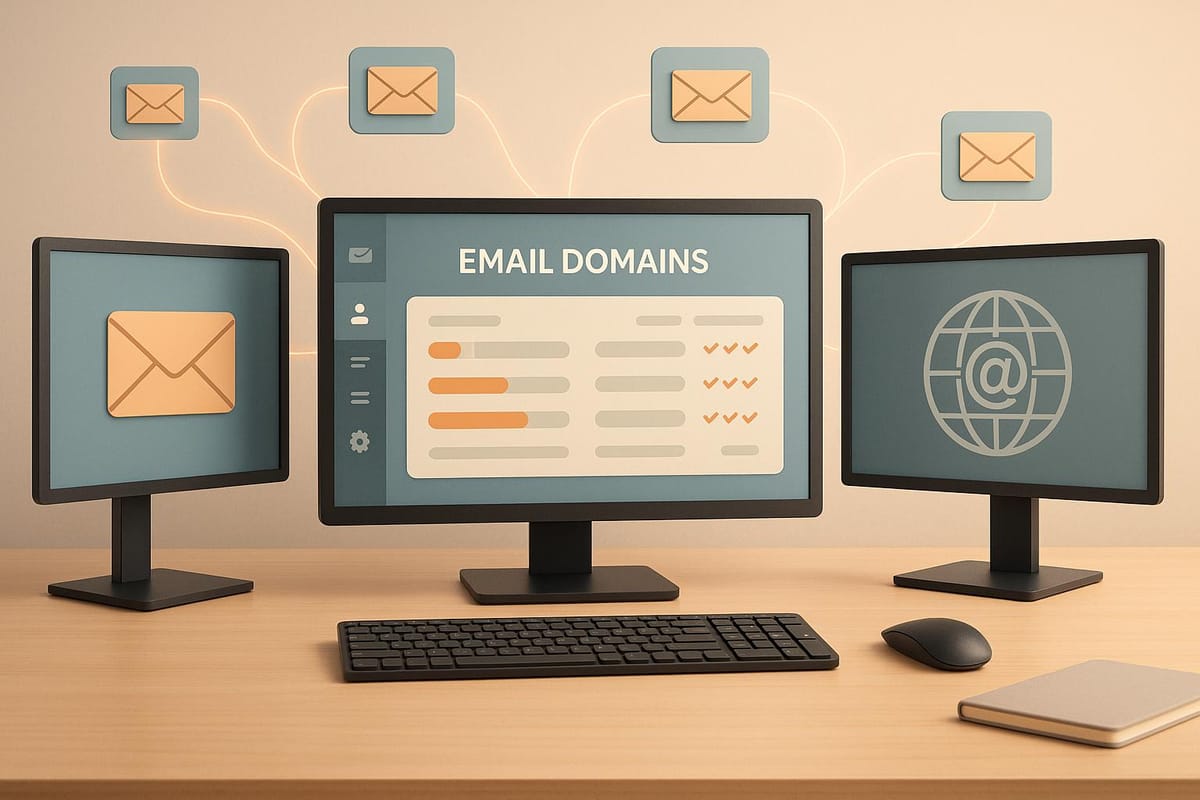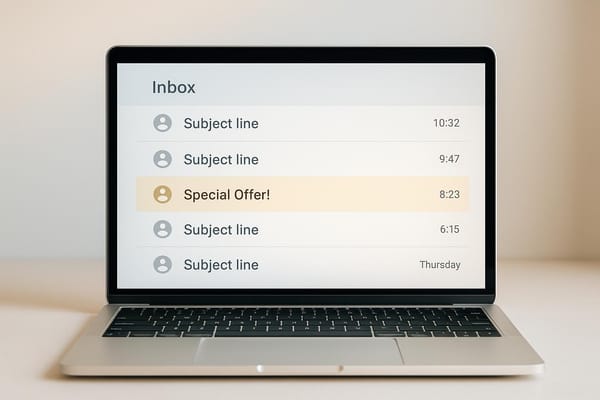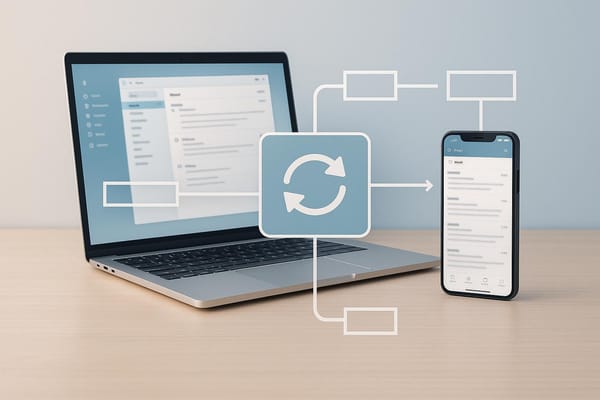How to Buy and Configure Bulk Email Domains
Learn how to effectively purchase and configure multiple email domains to improve deliverability and protect your sender reputation.

Managing email campaigns with one domain is risky - if it gets blacklisted, your outreach stops. Using multiple domains improves deliverability, avoids spam filters, and isolates reputation issues. Here's what you need to know:
- Choose Reliable Registrars: Look for bulk tools, automated DNS management, and API access. Pricing typically ranges from $8–$15/year for .com domains in the U.S.
- Buy the Right Domains: Use clean, professional names that align with your brand. Avoid numbers, hyphens, or spammy-looking extensions.
- Set Up DNS Records: Configure SPF, DKIM, and DMARC for authentication. This protects your domain reputation and ensures your emails are verified.
- Warm Up New Domains: Start slow - send 30–50 emails/day initially and gradually increase to build trust with email providers.
- Monitor Deliverability: Keep bounce rates below 2%, spam complaints under 0.1%, and regularly check domain reputation.
For a streamlined process, tools like Icemail.ai automate domain setup, DNS configuration, and deliverability monitoring. Plans start at $0.50/month, saving time and reducing manual errors.
I Automated Cold Email Domain Setup (5000 Domains in 1 Min)
How to Choose Domain Registrars
Picking the right domain registrar is a critical step in ensuring the smooth operation of your bulk email campaigns. A poor choice can lead to headaches like delayed DNS management, surprise fees, and unresponsive customer support. On the flip side, a dependable registrar keeps everything running smoothly, helping you avoid unnecessary interruptions.
What to Look for in a Registrar
When managing multiple domains, look for registrars that offer bulk domain search tools, portfolio management dashboards, and volume discounts. These features simplify the purchasing process and save you time.
Automated DNS management is another must-have. It allows for quick setup of SPF, DKIM, and DMARC records, reducing manual errors and streamlining your email authentication process.
Pricing is also a key factor. In the U.S., .com domains typically range from $8 to $15 per year. Be sure to check renewal rates to avoid unexpected price hikes after any introductory offers.
As your email operations expand, API access becomes increasingly important. The right registrar should integrate easily with your email platforms and automation tools, helping you avoid manual work and potential missteps.
Compliance with U.S. regulations is non-negotiable. Features like CAN-SPAM Act support and proper email authentication tools are essential for staying on the right side of the law.
Lastly, 24/7 customer support is indispensable for managing multiple domains. Opt for registrars with live chat or phone support to address issues like DNS propagation delays or domain transfers quickly and efficiently.
Top Choice: Icemail.ai

One standout option that checks all these boxes is Icemail.ai. This platform is specifically tailored to meet the needs of email campaigns, offering a suite of features that simplify domain management and improve email deliverability.
For starters, Icemail.ai’s 10-minute onboarding process lets you go from purchasing a domain to sending emails in no time. They also handle automated DNS setup for SPF, DKIM, and DMARC, saving you the hassle of manual configuration. With Cloudflare-managed domains included, you’ll enjoy enhanced DNS performance and security without any added charges.
Icemail.ai is designed with deliverability in mind, boasting a 99.2% inbox delivery rate. As Suprava Sabat from @AcquisitionX shared:
"Icemail.ai has transformed how I manage my email infrastructure. The automated setup for Google Workspace accounts, including DKIM, SPF, and DMARC configuration, saved me hours of work." – Suprava Sabat, @AcquisitionX
The platform also provides U.S.-based IP addresses for all mailboxes, which boosts deliverability for American audiences while ensuring compliance with CAN-SPAM regulations.
Pricing is flexible and affordable. Plans start at just $0.50 per month for IMAP/SMTP mailboxes, with pre-warmed mailboxes available for $5 per month. Google Admin and Microsoft mailboxes are priced at $2.50 and $3 per month, respectively, and all plans include automated authentication setup and live chat support.
Icemail.ai also excels in efficiency. While traditional registrars might take hours - or even days - to get your domains ready, Icemail.ai can have you up and running in just 30 minutes.
One standout feature is the AI Domain Finder, which simplifies domain selection by recommending available options that align with your email campaign needs. This tool helps you avoid domains that could harm your sender reputation, ensuring a solid foundation for your email infrastructure.
With these features, Icemail.ai makes domain management and email deliverability seamless and efficient, setting you up for success in your bulk email campaigns.
How to Purchase Domains for Email Campaigns
Once you've chosen a registrar, the next step is to purchase domains that protect your sender reputation and scale effectively with your email outreach. But first, you’ll need to identify what makes a domain the right fit for your campaign.
How to Select the Right Domains
A successful email campaign begins with selecting domains that have a clean history and a solid reputation. Before making a purchase, use tools like MXToolbox, Spamhaus, or Google Postmaster Tools to confirm the domain hasn’t been blacklisted or associated with spam. These checks are essential for ensuring your emails reach their intended audience.
When choosing a domain name, simplicity and professionalism are key. Shorter domains are easier to remember and more trustworthy than long, complicated ones. For instance, a domain like "acme-mail.com" is far more credible than something like "acme-bulk-email-1234.com." The goal is to use a name that recipients recognize and trust.
Your domains should reflect your brand identity but remain distinct from your primary business domain. For example, if your main domain is "acme.com", you might use something like "acmeoutreach.com" or "acmeconnects.com" for your campaigns. This approach keeps your main domain separate from bulk email activities while maintaining brand consistency.
Avoid domains with numbers, hyphens, or uncommon characters. These elements can make your domain harder to remember and less trustworthy. A name like "getacme.com" is far more effective than "acme-marketing-2025.biz" when it comes to deliverability and building recipient confidence.
The domain extension you choose also matters. .com remains the most trusted and widely recognized option, typically costing $10 to $20 per year in the U.S. While alternatives like .net or .io can work, they often require extra effort to build a positive reputation with email providers.
Tips for Buying Domains in Bulk
If you're planning to buy multiple domains, efficiency is key. Start by creating a list of domain names that align with your strategy. Many registrars offer bulk search tools, allowing you to check the availability of multiple domains at once. This saves time compared to searching for each domain individually.
When budgeting for bulk purchases, expect .com domains to cost $10–$20 annually per domain, plus any privacy protection fees. Many registrars offer discounts for bulk orders, which can help reduce costs, especially if you're purchasing a large number of domains.
In the U.S., most registrars accept payment methods such as credit cards and PayPal, with prices displayed in USD ($). Keep in mind that some registrars offer low introductory rates that increase during renewal, so factor both initial and renewal costs into your budget.
For a more streamlined process, consider tools like Icemail.ai's AI Domain Finder. This service uses AI to suggest available domains that match your branding and keyword needs. It checks availability across multiple extensions and filters out domains that could harm your sender reputation. With its AI-driven recommendations, you can save hours of manual research while ensuring your domains meet best practices for email deliverability. Icemail.ai is also praised for its fast integration and positive feedback from email professionals.
If you're purchasing through traditional registrars, try to complete your bulk order in a single transaction. This can unlock volume discounts and simplify domain management by keeping everything under one account. Additionally, choose a registrar that supports easy DNS management, as you'll need to configure authentication records for each domain.
Lastly, ensure compliance with U.S. regulations by registering domains with accurate WHOIS information to meet CAN-SPAM Act requirements. While you can use privacy protection services, it's crucial to maintain the ability to verify ownership when requested by email providers or regulatory authorities.
How to Set Up DNS Records for Email Authentication
Once you've purchased your domains, the next step is setting up DNS records to authenticate your emails. These records act as your domain's security credentials, helping email providers verify that your messages are legitimate and protecting your sender reputation from spoofing attacks.
SPF, DKIM, and DMARC Explained
Email authentication revolves around three key DNS records that work together to confirm your identity as a valid sender:
- SPF (Sender Policy Framework): This record specifies which mail servers are authorized to send emails on behalf of your domain. Think of it as your domain's "approved sender list." Email providers check this record to ensure the sender is legitimate.
- DKIM (DomainKeys Identified Mail): DKIM adds a digital signature to your outgoing emails. This cryptographic signature ensures your message hasn't been tampered with during transit and confirms it was sent from an authorized source. The private key used to create the signature is stored on your email server, while the public key is published in your DNS records for verification.
- DMARC (Domain-based Message Authentication, Reporting, and Conformance): DMARC ties everything together by enforcing policies based on SPF and DKIM results. It tells receiving servers what to do with emails that fail authentication - whether to deliver, quarantine, or reject them. DMARC also provides detailed reports, giving you insights into authentication results and potential spoofing attempts.
Major email providers like Google, Yahoo, and Microsoft require proper authentication for high-volume senders (typically over 5,000 emails per day). Without these records, your emails might land in spam folders or get rejected entirely, which can seriously harm your email campaigns.
DNS Setup Instructions
To set up these authentication records, you'll need to add specific TXT entries to your domain's DNS zone. While the exact steps depend on your DNS provider, the process generally follows a similar structure:
-
SPF Records: Add a TXT record to your root domain. The value will specify which servers are authorized to send emails for your domain. For example, an SPF record might look like this:
v=spf1 include:your-email-provider.com ~all
The "include" directive lists your email provider's servers, while "~all" indicates a soft fail for unauthorized servers. If you're using multiple email services, you can include multiple providers in a single SPF record. Remember, only one SPF record is allowed per domain. -
DKIM Records: Start by generating a key pair through your email provider. Once you have the public key, add a TXT record named something like
selector1._domainkey.yourdomain.com. The selector (e.g., "selector1") is determined by your provider and helps identify the correct key. Paste the public key as the record's value. -
DMARC Records: Use the name
_dmarc.yourdomain.comfor this TXT record. A basic DMARC entry might look like this:
v=DMARC1; p=none; rua=mailto:dmarc-reports@yourdomain.com
The "p=none" policy is for monitoring only, while "rua" specifies where to send aggregate reports on authentication outcomes.
Most DNS management interfaces make it easy to add these records, but always allow 24-48 hours for propagation. After setup, use tools like MXToolbox or your email provider's checker to verify everything is working correctly.
Common errors include creating multiple SPF records (only one is allowed), using incorrect DKIM selectors, or forgetting to update records when switching email providers. Double-check your syntax and test thoroughly before launching email campaigns.
Automated Setup with Icemail.ai
Manually configuring DNS records can be tedious and prone to mistakes, especially if you're managing multiple domains for large-scale email campaigns. Icemail.ai simplifies this process by automating the setup of SPF, DKIM, and DMARC records as part of its email infrastructure service.
Icemail.ai's system generates and applies the correct authentication records for each domain, saving you hours of manual work. What typically takes a significant amount of time can now be completed in just minutes. Their automation also ensures consistency across your email infrastructure, reducing the risk of errors.
Beyond setup, Icemail.ai monitors your DNS records for misconfigurations or unauthorized changes that could impact email deliverability. This proactive maintenance helps ensure your authentication remains effective without requiring constant manual oversight.
For businesses managing multiple domains, this automation is a game-changer. Instead of manually configuring records for each domain - an error-prone and time-consuming task - you can deploy accurate, standardized authentication records across your entire domain portfolio. Icemail.ai offers this feature in all their plans, starting at $0.50 per month for IMAP/SMTP mailboxes. They also provide Google Workspace integration for $2.50 per month.
With features like "10-Min Onboarding" and "Instant Domain Setup", you can connect existing domains or configure new ones with full authentication in under 30 minutes. This streamlined process makes it far easier to manage email authentication at scale.
How to Maintain High Email Deliverability
Keeping your emails out of spam folders and ensuring a strong sender reputation requires consistent effort. High deliverability isn’t something you set up once and forget - it demands ongoing attention to your domain health, compliance with U.S. email laws, and regular monitoring of email performance.
How to Protect Domain Reputation
Your domain reputation is a key factor in whether your emails land in inboxes or get flagged as spam. Email service providers closely watch your sending behavior, so maintaining a positive reputation is essential.
Start with gradual domain warming. New domains don’t have a sending history, which can make them appear suspicious. In the first week, send only 30–50 emails per day from each new domain, and then gradually increase the volume over the next 2–3 weeks. This slow growth helps build trust with major providers like Gmail, Yahoo, and Microsoft.
To avoid damaging your reputation, keep bounce rates low. Regularly clean your email lists to remove invalid addresses, as hard bounces (permanent delivery failures) can significantly harm your sender score.
Monitor spam complaints closely. Even a 0.5% complaint rate can hurt your deliverability. The best bulk senders aim for rates below 0.1% by focusing on engaged audiences and offering valuable content in their emails.
For those sending large volumes of emails, rotating domains is a smart strategy. Instead of overloading a single domain, spread your campaigns across multiple domains to keep your sending behavior under the radar.
Lastly, ensure your email authentication is flawless. Every domain should have properly configured SPF, DKIM, and DMARC records. Regular audits can help identify and fix any issues before they affect your campaigns. These practices should also align with U.S. email laws to ensure compliance.
US Email Law Compliance
Following the CAN-SPAM Act isn’t just about avoiding legal trouble - it can also improve your deliverability by reducing spam complaints.
Every email must include a clear and functional unsubscribe option, typically found in the footer. Unsubscribe requests should be processed within 10 business days, though processing them faster can further reduce complaint rates.
Make sure the "From" field accurately reflects the sender's identity, and always include a valid physical mailing address. Your subject lines should honestly represent the email’s content, and keeping records of how you obtained email addresses can help resolve any compliance issues that arise.
Better Deliverability with Icemail.ai
Managing email deliverability manually can be a tedious and error-prone process. That’s where Icemail.ai comes in - it simplifies the entire process with tools tailored for bulk email infrastructure, covering both technical and compliance needs.
Its instant domain setup feature automatically configures all authentication records - SPF, DKIM, and DMARC - correctly, saving you hours of manual DNS work. What would normally take hours is completed in just minutes.
Icemail.ai also offers pre-warmed mailboxes for $5 per month. This feature provides domains with a pre-established sending history, skipping the usual 2–3 week warming period and allowing you to start campaigns immediately with better inbox placement.
Other benefits include a US-based IP infrastructure, which often gets more favorable treatment from domestic email providers, and compliance monitoring to ensure unsubscribe requests and complaint rates are properly managed. The platform’s real-time analytics dashboard gives you clear visibility into your deliverability metrics, making it an essential tool for businesses managing 10 or more domains. This level of automation and insight makes maintaining a strong sender reputation far more manageable.
Best Practices for Cold Email Infrastructure
Creating a scalable cold email infrastructure involves much more than just setting up domains and mailboxes. The most effective email campaigns hinge on automated systems that can manage hundreds of domains while ensuring compliance and maintaining high deliverability rates. Smart automation combined with regular monitoring forms the backbone of sustainable growth. Let’s dive into how automation simplifies domain and mailbox management.
How to Automate Domain and Mailbox Management
When managing large-scale campaigns, manual setup quickly becomes unmanageable. Tasks like configuring DNS records, setting up authentication protocols, and creating mailboxes can take weeks if done manually. This is where automation platforms come into play, eliminating these time-consuming hurdles.
Icemail.ai is a standout tool in this space, offering a streamlined three-step setup process that configures hundreds of mailboxes in mere minutes. The platform can connect to your existing domains or help you find new ones using its AI-powered domain finder. It also automates the configuration of essential DNS records, including SPF, DKIM, and DMARC authentication, cutting down tasks that once took hours to just seconds.
Another key feature is Icemail.ai's bulk mailbox purchasing option, which uses AI-powered autofill to speed up the configuration process. Agencies managing multiple clients will appreciate the separate workspace accounts that make handling various campaigns efficient and organized. With these tools, you can have a fully operational cold email infrastructure up and running in just 30 minutes, compared to the days or weeks required for manual setups.
Additionally, the platform’s pre-warmed infrastructure eliminates the typical delays associated with launching campaigns, ensuring high deliverability from the start.
For ongoing management, bulk update tools allow you to modify mailbox details - such as names and profile pictures - across hundreds of accounts in one go. This is especially helpful when running large campaigns or maintaining consistent branding for clients.
While automation is crucial for getting started, consistent monitoring is what ensures long-term success.
Monitoring and Maintenance Tasks
Even with a robust automated setup, regular monitoring is essential to maintain optimal performance. Beyond the initial DNS setup and registrar processes, continuous oversight helps identify and address potential issues before they affect your campaigns. Regularly auditing your domain portfolio is a must - check domain reputation, monitor bounce and complaint rates, and verify DNS records to stay ahead of any problems.
Key metrics to watch include keeping bounce rates below 2%, spam complaints under 0.1%, and achieving strong inbox delivery rates. Icemail.ai boasts an impressive 99.2% inbox delivery rate, but maintaining this level requires consistent monitoring of your sending practices and ensuring your email lists are clean and well-maintained.
As your infrastructure expands, maintaining DNS records becomes even more critical. Automated platforms simplify updates, but if you’re using manual setups, regular audits are necessary to ensure SPF, DKIM, and DMARC records comply with the latest email service provider standards.
To avoid overloading any single domain, implementing domain rotation strategies is key. Integrated portfolio management tools make this process far more efficient than manually tracking everything in spreadsheets.
Compliance is another area that demands attention. Beyond technical configurations, adhering to CAN-SPAM guidelines is crucial. This includes processing unsubscribe requests within 10 business days, maintaining accurate sender information, and including a valid physical address in every email. Many automated platforms offer compliance alerts, helping you catch potential issues early.
For the best results, combine automated alerts with weekly manual reviews. Set up notifications for unusual bounce rates, authentication failures, or drops in reputation, and schedule weekly evaluations of overall performance metrics. This dual approach helps you address immediate issues while also keeping an eye on long-term trends.
Finally, maintaining good list hygiene is essential. Regularly remove hard bounces, suppress complainers, and segment contacts based on engagement levels. These practices protect your sender reputation and ensure your cold email infrastructure continues to deliver the results you need.
Conclusion: Building Your Email Infrastructure
Creating a strong email infrastructure starts with deliberate steps and the right tools, building on the strategies outlined in this guide. It begins with choosing a dependable domain registrar that offers bulk management, solid privacy features, and transparent pricing - key elements for scalable operations. Once that's in place, securing compliant domains lays the groundwork for success.
The next step is swift and accurate DNS authentication, which is critical for ensuring your emails land in inboxes. Proper DNS setup directly impacts deliverability rates, and manual configuration can be both time-consuming and prone to errors, potentially harming your sender reputation. Achieving and maintaining high deliverability also requires ongoing monitoring, a careful domain warming plan, and strict adherence to U.S. email regulations.
This is where Icemail.ai stands out for businesses serious about email infrastructure. The platform offers a 99.2% inbox delivery rate and takes just 30 minutes to complete setup. With automated configuration for DKIM, DMARC, and SPF, it eliminates much of the complexity that comes with traditional methods. Plus, its competitive pricing makes it an efficient choice.
For agencies and businesses managing multiple clients, Icemail.ai’s features like separate workspace accounts and bulk management tools make scaling easier than ever. Its AI-powered domain finder, instant DNS record management, and one-click mailbox exports turn what used to be a technical headache into a smooth, streamlined process. Using these strategies ensures your email campaigns are not just functional but highly effective.
FAQs
Why should I use multiple domains for bulk email campaigns, and how does it impact deliverability?
Using multiple domains for bulk email campaigns plays a key role in safeguarding your primary domain's reputation while improving email deliverability. By keeping bulk email activities on separate domains, you minimize the chances of blacklisting or deliverability problems impacting your main domain, which is typically reserved for important communications.
To ensure your emails reach inboxes, it’s crucial to set up DNS records such as SPF, DKIM, and DMARC correctly. These records verify your emails, protect against domain spoofing, and establish trust with email providers. This authentication process significantly boosts the likelihood of your messages being delivered successfully. Opting for a premium service like icemail can simplify the setup process, enhance inbox placement, and provide dependable support tailored specifically for your email campaigns.
What should I look for in a domain registrar when purchasing and managing domains for bulk email campaigns?
When managing bulk email domains, choosing the right domain registrar can make a world of difference. Focus on registrars that offer features aimed at simplifying domain management while boosting efficiency. Start by looking for affordable options that provide discounts for bulk domain purchases. Having centralized management tools is also a game-changer, allowing you to handle all your domains from a single interface.
Security should be a top priority. Opt for registrars that include two-factor authentication and domain privacy to safeguard your domains. Additionally, automatic renewal options are a must to prevent accidental lapses in service. And don’t overlook the importance of responsive customer support - you’ll want a team that’s ready to assist whenever issues arise.
If you’re after premium service and quicker setup, a trusted provider like icemail could be a great choice. It’s well-regarded for its dependable performance and glowing user reviews.
How does Icemail.ai make setting up and managing DNS records for email authentication easier?
Icemail.ai takes the hassle out of setting up crucial DNS records like SPF, DKIM, and DMARC by automating the entire process. No more manual configurations - this saves you time and minimizes the chance of mistakes.
By using Icemail.ai, you can ensure your email campaigns are properly authenticated, which boosts deliverability and increases the chances of landing in your recipients' inboxes. Its fast, reliable service simplifies building a compliant and scalable email system.





